- Home
- Types of Sailboats
- Cutter Rig Sailboat Advantages
Why the Cutter Rig Sailboat is the Best Choice for Offshore Cruising
In a Nutshell...
For long-distance cruising, the cutter rig is unmatched in its versatility, safety, and ease of handling, particularly in varied weather conditions. Its two-headsail configuration breaks down sail area into smaller, more manageable parts, which simplifies reefing and sail changes in heavy weather. While it may not point as high to the wind as a sloop in ideal conditions, its balanced sail plan on a reach and its inherent comfort and security make it the preferred choice for sailors prioritizing a safe & stress-free passage over pure upwind performance.
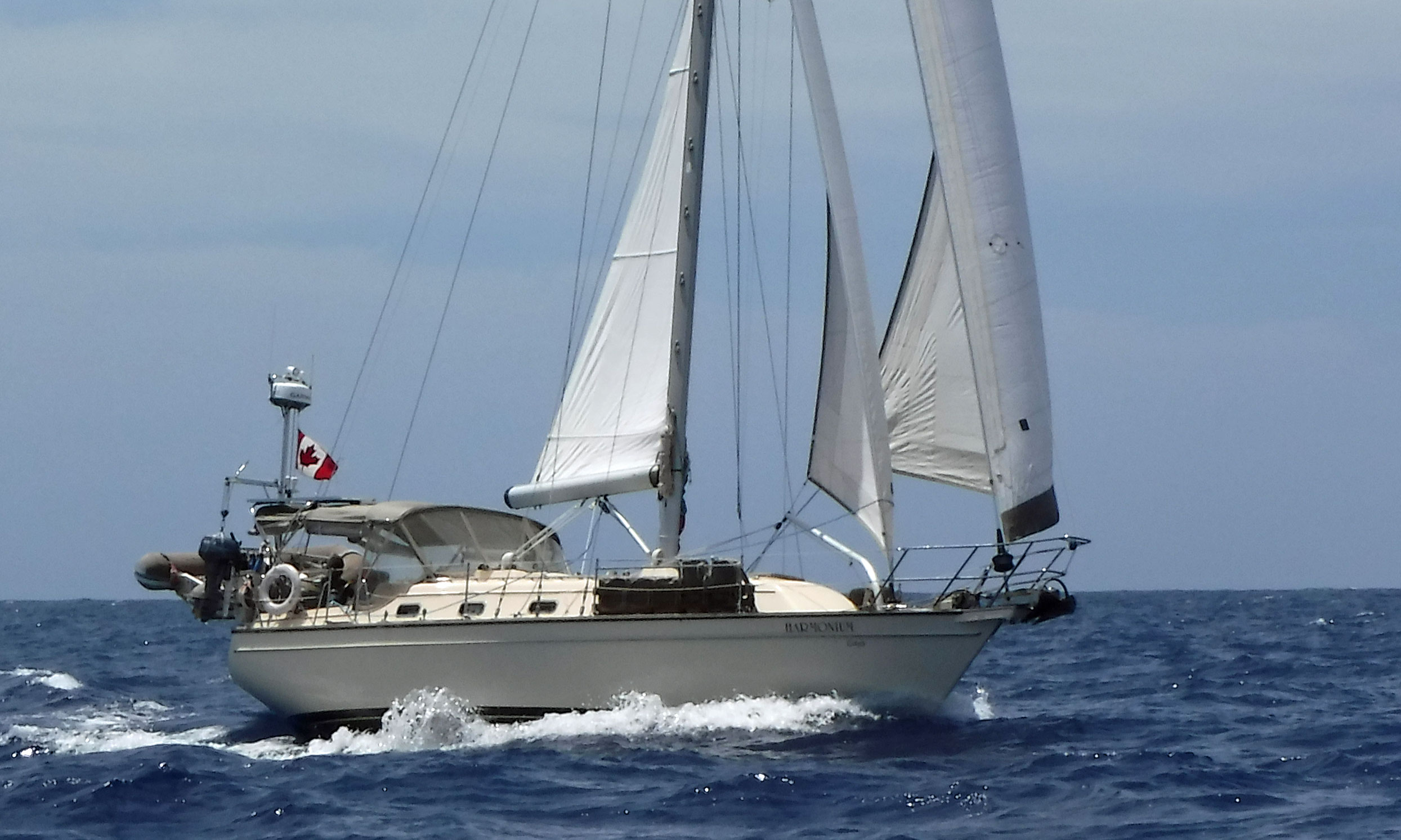 'Harmonium', an Island Packet 380 with a staysail set on a self-tacking boom
'Harmonium', an Island Packet 380 with a staysail set on a self-tacking boomTable of Contents
- What Is a Cutter Rig Sailboat & How Does It Work?
- How Does a Cutter Rig Compare to a Sloop?
- Tacking a Cutter Rig: A Step-by-Step Guide
- Modern Innovations & Upgrades for Your Cutter Rig
- Sailing Off the Wind & in Heavy Weather
- Bowsprit Cutters: Performance & Practicality
- Hanked-On Staysails: A Simple & Secure Solution
- A Final Word
- FAQs About the Cutter Rig Sailboat
What Is a Cutter Rig Sailboat & How Does It Work?
The cutter rig is a specific type of sail plan featuring two headsails: a yankee (a high-cut jib) set on the forestay and a staysail set on an inner forestay. This setup allows for a wide range of sail combinations, providing the flexibility to adapt to changing wind conditions without relying on a single, large foresail.
The beauty of this rig, and the reason many seasoned offshore sailors like myself favor it, is its ability to break down the sail area into more manageable components. For instance, my self-build wood-epoxy cutter, Alacazam, is rigged as a cutter. On a calm day, we can fly both a yankee and staysail to maximize downwind performance. But when the wind picks up, the inner staysail provides a powerful yet easily controlled sail plan that balances beautifully with a reefed mainsail. This capability is a significant factor in why a cutter rig is often seen as the ultimate cruising setup.
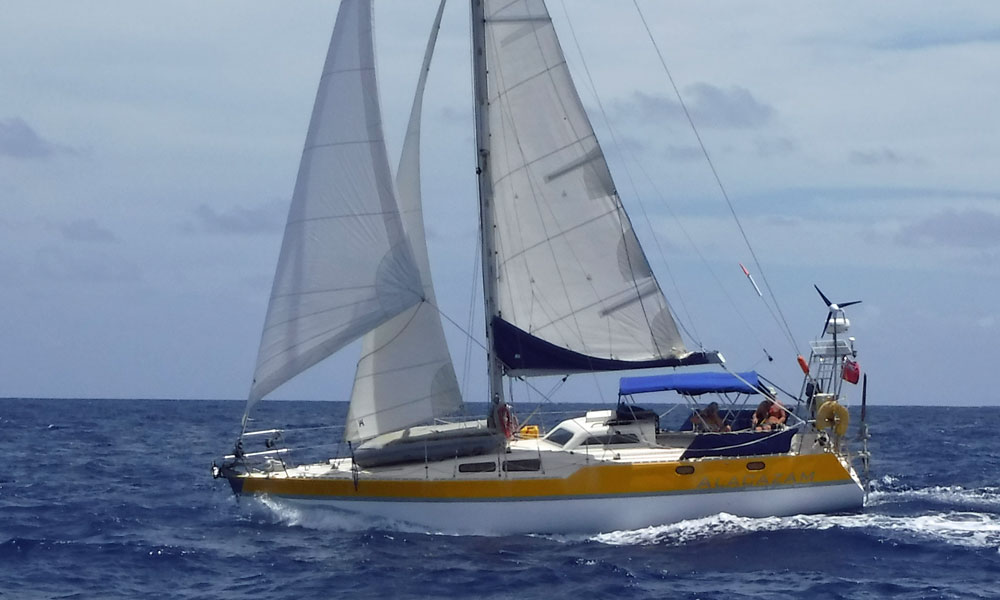 'Alacazam' dips her bow on a reach
'Alacazam' dips her bow on a reachHow Does a Cutter Rig Compare to a Sloop?
While a sloop rig, with its single headsail, is excellent for upwind performance in light to moderate airs, the cutter rig excels in versatility & heavy weather handling. The differences are best understood side-by-side.
| Feature | Cutter Rig | Sloop Rig |
|---|---|---|
| Headsails | Two (yankee & staysail) | One (jib or genoa) |
| Windward Performance | Good, but may not point as high as a sloop in light air | Excellent in light & moderate wind; loses efficiency when reefed |
| Heavy Weather | Superior. Easily reduces sail area by furling the yankee, leaving a balanced staysail & reefed main | Requires a storm jib hanked onto a removable inner forestay, or relies on an inefficient reefed headsail |
| Sail Handling | Slower tacking due to two headsails, but easier to handle in terms of physical loads. | Faster & simpler tacking. Winching loads can be very high on larger boats. |
| Versatility | High. Many sail combinations possible (yankee alone, staysail alone, both, etc.). | Lower. Relies on one sail, which can be reefed for a less efficient shape. |
| Rigging Cost | Higher due to additional stays, sails, and hardware. | Lower. Requires less hardware. |
Tacking a Cutter Rig: A Step-by-Step Guide
Tacking a cutter rig is often perceived as more complex than with a sloop, but with practice, it becomes second nature. On my boat, the process is smooth & systematic. We start by centralizing the mainsheet. As we begin to turn, we ease the yankee sheet, allowing it to flap. We then adjust the runners (if used) to maintain proper mast support. Once we’re turned, we set the staysail and then trim both sails to the new tack, checking the telltales for optimal sail shape.
This process is a bit more involved than with a single-headsail sloop, but it's a small price to pay for the versatility & security of the rig. For those with a self-tacking staysail, the process is significantly simplified, requiring only the trimming of the yankee.
Or graphically...
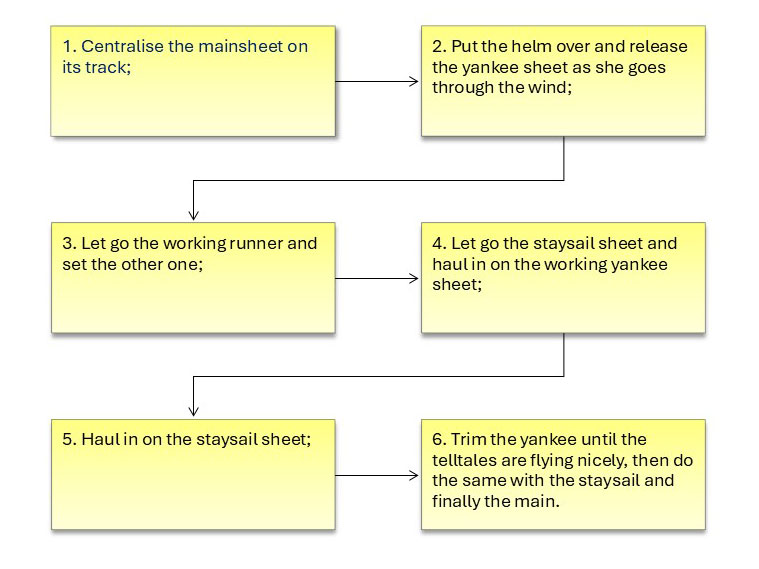
Modern Innovations & Upgrades for Your Cutter Rig
The cutter rig has evolved far beyond its traditional roots. Modern technology & materials have made it lighter, more responsive, & even easier to manage.
- Carbon Fiber Masts & Composite Materials: Lighter masts reduce weight aloft, leading to a more stable boat and improved performance.
- Electronic Furling Systems: Automation makes sail changes and reefing as simple as pushing a button, a huge benefit for short-handed crews or in difficult conditions. This allows for quick, safe transitions without needing to go to the bow.
- Conversion & Upgrading: For those with a traditional sloop, converting to a cutter rig is a popular option. It typically involves adding an inner forestay, modifying backstays, and installing new furlers & deck hardware. This modification significantly improves load distribution and creates a more balanced sail plan for long-distance passages.
Sailing Off the Wind & in Heavy Weather
The cutter rig truly shines when reaching, with its balanced sail plan working harmoniously with self-steering systems. The two headsails distribute the sail area, making the boat exceptionally stable on a steady course.
When the wind builds, the cutter rig offers a fantastic, gradual reduction of sail. The process begins with reefing the mainsail, followed by furling the yankee. This leaves a balanced sail plan with a deep-reefed mainsail & a full staysail, ready to handle conditions up to a gale. In my experience, this setup provides a remarkable sense of security and control when the weather turns foul. For even more extreme conditions, a trysail and storm jib can be easily set on the inner forestay.
Here's the usual reefing sequence...
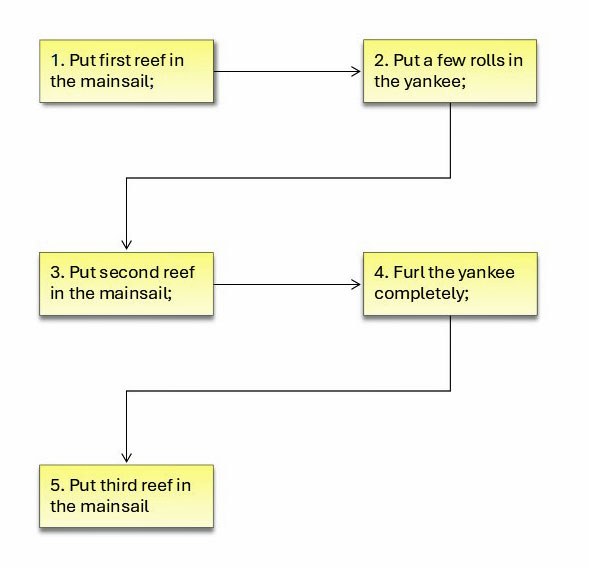
Bowsprit Cutters: Performance & Practicality
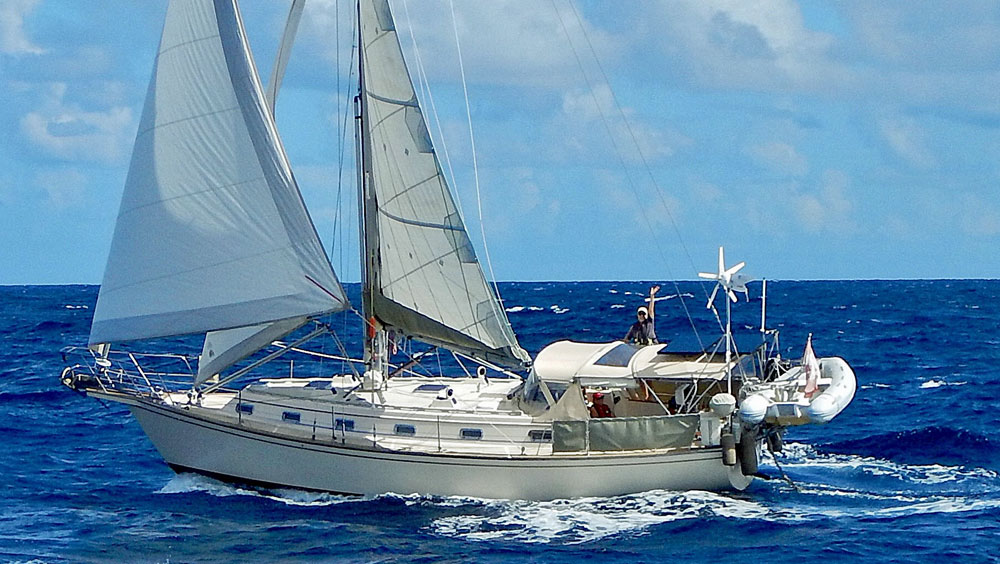 Like many of the Island Packet cutters, the IP40 sports a bowsprit
Like many of the Island Packet cutters, the IP40 sports a bowspritA notable variation of the cutter rig involves a bowsprit, a spar that extends forward from the bow. This design is particularly common on classic, heavy displacement cruising boats. The primary purpose of a bowsprit is to increase the size of the foretriangle—the area where your headsails are set—without needing a taller mast. This allows the boat to carry a larger sail area, which is a significant advantage in light winds, helping to drive the boat forward efficiently.
On a practical level, a bowsprit also offers a strong, forward platform for handling sails and anchors. However, it's not without its tradeoffs. The extra length can make mooring or navigating crowded marinas more challenging. It also adds weight to the bow, which can affect the boat's motion in a seaway. From a sailing perspective, the extended forestay can create a more balanced sail plan for off-the-wind sailing, but the rig can be less effective when beating directly into a strong headwind.
This configuration truly shows its worth when reaching across the ocean in steady winds, where the larger sail area helps maintain good boat speed and a comfortable motion.
Hanked-On Staysails: A Simple & Secure Solution
While modern roller-furling systems offer incredible convenience, many experienced sailors—myself included—prefer a hanked-on staysail for offshore & heavy weather sailing. The primary merit of this setup is its simplicity and security, particularly when conditions deteriorate.
A hanked-on staysail attaches to the inner forestay with a series of snap hooks, or "hanks." This direct attachment provides a stronger, more reliable connection than a furling system. Most importantly, it makes the process of attaching a dedicated storm staysail far more straightforward. In a building gale, you simply drop the primary staysail, hank on the smaller, high-visibility storm sail, and hoist it. This maneuver can be done quickly and securely without the risk of a furling system jamming or a sail blowing out, offering a vital layer of safety when you need it most. While it requires a trip to the foredeck, the ability to rapidly and securely deploy a storm sail is a peace-of-mind factor that many long-distance cruisers value above all else.
A Final Word...
My experience as an ocean sailor has given me a deep appreciation for the cutter rig’s blend of tradition and modern function. Its reliability and ease of handling in a variety of conditions are what make it, in my opinion, the top choice for anyone setting off on a long cruise.
Whether you’re just starting your sailing journey or are a seasoned sailor considering your next boat, understanding the different sail rigs is crucial. To explore this topic further and see how the cutter rig fits into the wider world of sailboat design, be sure to check out “The Ultimate Guide to Sailboats & Rigs: Sloops, Ketches & More.”
Article written by Dick McClary, RYA Yachtmaster & Yachting Journalists Association (YJA) member.
FAQs About the Cutter Rig Sailboat
Is a cutter rig difficult to sail single-handed?
Is a cutter rig difficult to sail single-handed?
Not at all. With modern furling systems and a well-thought-out deck layout, a cutter rig can be sailed effectively by one person. The ability to break up the sail area into smaller, more manageable sails actually makes it easier for a short-handed crew to handle in stronger winds.
Is a cutter rig slower than a sloop?
Is a cutter rig slower than a sloop?
Not necessarily. While a sloop may have a slight advantage when sailing directly into the wind in calm conditions, the cutter's versatility often gives it an edge on a broad reach & in rougher seas. The ability to carry an efficient sail plan in a wide range of conditions often results in faster overall passage times for cruising.
Can a sloop be converted to a cutter?
Can a sloop be converted to a cutter?
Yes. Many sailboats are designed with the option for an inner forestay, making the conversion relatively straightforward. This modification is a popular choice for sailors who want to improve their boat's offshore capabilities.
What are the primary maintenance considerations for a cutter rig?
What are the primary maintenance considerations for a cutter rig?
A cutter rig requires regular checks on the additional hardware, including the inner forestay, staysail furler, and associated turnbuckles. It's crucial to inspect these components for wear and corrosion, especially where the staysail's running backstays may chafe against the main. With the extra sails, it's also important to ensure proper storage and regular cleaning to prevent mildew.
How does a cutter rig perform when sailing "wing on wing"?
How does a cutter rig perform when sailing "wing on wing"?
While it's technically possible to sail a cutter rig "wing on wing," it is not the most efficient configuration. The inner staysail can block the wind from reaching the yankee, disturbing the airflow. For sailing directly downwind, most experienced sailors prefer to drop both headsails and hoist an asymmetric spinnaker, which provides a much cleaner sail shape and superior performance.
Sources Used
- American Sailing, "What's in a Rig? The Cutter Rig" https://americansailing.com/articles/whats-in-a-rig-cutter/
- Rustler Yachts, "Cutter or sloop rig? Which is Best for Offshore and Ocean Cruising" https://www.rustleryachts.com/cutter-or-sloop-rig/
- Yachting Monthly, "50 Innovations That Changed Sailing" https://www.yachtingmonthly.com/gear/50-innovations-that-changed-sailing-32833
- Stephens Waring Yacht Design, "Understanding the Evolution of Headsails" https://stephenswaring.com/the-pain-of-progress-understanding-the-evolution-of-headsails/
Recent Articles
-
Passoa 47 Sailboat Review: Comprehensive Specs & Performance Analysis
Jan 04, 26 04:57 AM
Discover the Passoa 47, a legendary aluminium blue water cruiser by Garcia. Explore technical specifications, design ratios, and why its lifting keel is a game-changer for offshore sailors. -
Sailboat Wheel Steering Maintenance & Inspection Checklist
Dec 30, 25 02:32 PM
Keep your vessel’s helm responsive and reliable with our expert maintenance checklist. Master cable tensioning and system inspections to avoid mid-passage failures. -
Modern Boat Electronics and the Latest Marine Instruments
Dec 20, 25 05:27 PM
Should sailboat instruments be linked to the latest boat electronics as a fully integrated system, or is it best to leave them as independent units?












